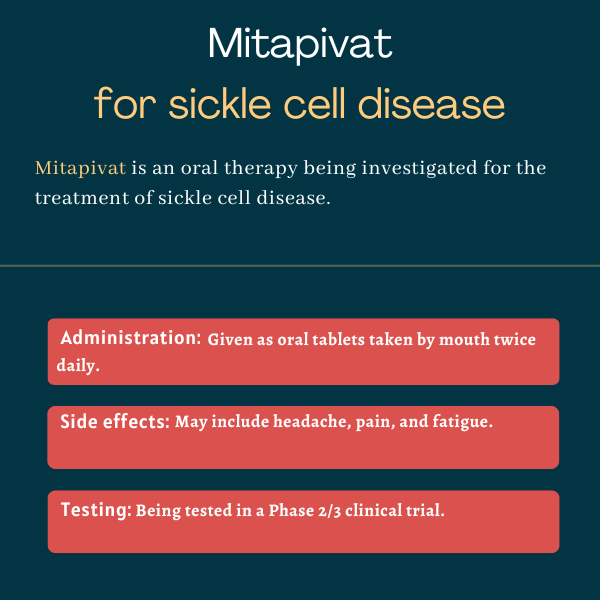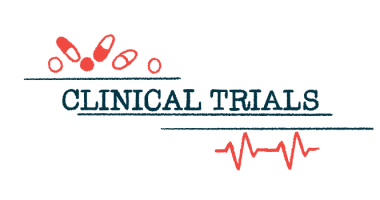Mitapivat for sickle cell disease
Last updated May 30, 2024, by Lindsey Shapiro, PhD

What is mitapivat for sickle cell disease?
Mitapivat, formerly known as AG-348, is an oral therapy being investigated as a treatment for sickle cell disease (SCD).
It’s being developed by Agios Pharmaceuticals. Mitapivat is the active ingredient in Pyrukynd, an approved therapy from Agios used for treating adults with pyruvate kinase deficiency, a rare genetic disorder that causes red blood cells to die prematurely. Mitapivat is also being developed as a possible treatment for children with pyruvate kinase deficiency and for people with various types of thalassemia, another blood disorder.
The therapy has been granted orphan drug status in the U.S. for SCD.
Therapy snapshot
| Treatment name: | Mitapivat |
| Administration: | Being tested in sickle cell disease as oral tablets |
| Clinical testing: | In Phase 2/3 clinical testing |
How does mitapivat work in sickle cell disease?
SCD patients produce an abnormal form of hemoglobin, the protein responsible for carrying oxygen in red blood cells, called hemoglobin S (HbS). This faulty type of hemoglobin tends to clump up, or polymerize, into rigid fibers that cause red blood cells to take on an unusual sickle-like shape. Sickled red blood cells stick to each other and block blood vessels, impairing oxygen delivery and driving painful vaso-occlusive crises (VOCs). They’re also more prone to being broken down and destroyed prematurely, a process also known as hemolysis.
Mitapivat is an activator of pyruvate kinase (PK), an enzyme involved in generating cellular energy by breaking down blood sugar as part of a process called glycolysis. Two things happen when PK is activated that are thought to be of benefit in SCD.
First, there’s an increase in the levels of adenosine triphosphate (ATP), the molecule produced by glycolysis that cells use as a source of energy. ATP is essential for red blood cell integrity and survival, but it is decreased in SCD.
Simultaneously, there’s a decrease in a molecule called 2,3-diphosphoglycerate (2,3-DPG). This molecule, which is increased in SCD patients, promotes the deoxygenation of hemoglobin, the state the protein must be in to polymerize. By reducing 2,3-DPG, HbS affinity for oxygen is increased, helping to stabilize the protein and prevent it from clumping up into the rigid fibers that cause sickling.
Through these mechanisms, mitapivat should help prevent red blood cell sickling and hemolysis, thereby easing the symptoms of SCD.
How will mitapivat be administered in sickle cell disease?
In clinical trials involving SCD patients, mitapivat has been given as an oral tablet at doses that range from 5 to 100 mg, taken twice daily.
Mitapivat in sickle cell disease clinical trials
Mitapivat was first tested in SCD patients in a dose-finding Phase 1 study (NCT04000165) conducted in collaboration with the National Institutes of Health. The trial enrolled 17 adults with SCD, ages 18-70, who received multiple dose levels of mitapivat that ranged from 5 to 100 mg twice daily, with each dose being taken for two weeks.
The therapy was well tolerated and led to increases in hemoglobin and ATP, along with decreases in markers of hemolysis and 2,3-DPG.
The study’s participants were able to enter an ongoing long-term extension study (NCT04610866), where all are receiving mitapivat twice daily for up to six years. Interim results indicated the therapy remained well tolerated and blood-related improvements were sustained for up to about 1.5 years.
ESTIMATE Phase 2 trial
The Agios-supported Phase 2 ESTIMATE trial (EudraCT: 2019-003438-18) was a proof-of-concept study that tested mitapivat’s safety and efficacy in a small group of SCD patients, ages 16 and older, with a history of VOCs and/or other SCD complications.
In an eight-week dose-finding study, nine participants were treated with mitapivat twice daily for two months (up to 100 mg). Results showed the therapy significantly reduced red blood cell sickling. It also increased hemoglobin’s oxygen affinity, lowered 2,3-DPG levels, increased the ATP/2,3-DPG ratio, and reduced hemolysis marker levels.
The participants continued treatment in a one-year, fixed-dose extension period where sustained improvements in lab markers of red blood cell sickling and hemolysis continued to be observed. Moreover, the annualized rate of vaso-occlusive events, encompassing VOC’s and other SCD-related complications, was significantly reduced with mitapivat. Participants are now continuing long-term treatment in a prolonged extension period.
RISE UP Phase 2/3 trial
The ongoing Agios-sponsored Phase 2/3 RISE UP clinical trial (NCT05031780) is being conducted to evaluate mitapivat’s safety and efficacy in a larger group of about 267 SCD patients, ages 16 and older, who’d had two to 10 VOCs in the previous year.
In its Phase 2 dose-finding portion, 79 participants were randomly assigned to receive one of two doses of mitapivat (50 or 100 mg) or a placebo, taken twice daily, for 12 weeks, or about three months.
Results showed the proportion of patients who saw an increase in hemoglobin of at least 1 gram per deciliter (g/dL) — considered a clinically meaningful response — was significantly higher in the mitapivat groups (46.2% with 50 mg, 50% with 100 mg) compared with a placebo, where only 3.7% of the patients were considered responders. Hemoglobin increases were seen as early as two weeks into the trial with both doses and were sustained to week 12.
Moreover, annualized rates of VOCs were more than halved with either dose of mitapivat relative to a placebo. Specifically, annualized VOC rates were 0.83 in the 50 mg group, 0.51 in the 100 mg group, and 1.71 with a placebo. Improvements in markers of hemolysis and red blood cell creation, as well as reductions in fatigue, were also observed with mitapivat, with the magnitude of responses generally higher with the higher dose.
The participants in the Phase 2 part can enter an open-label extension phase, where all will receive daily mitapivat for up to 216 weeks, or a little over four years. In its Phase 3 part, the participants will be randomly assigned to mitapivat (100 mg) or a placebo twice daily for a year. This will be followed by a similar open-label extension period.
Other ongoing studies
Agios is planning a Phase 2 clinical trial (NCT06286046) that will test the effects of twice daily mitapivat (100 mg) in around 40 SCD patients who have nephropathy, or a loss of kidney function. Patients will be treated for up to two years, with the main goal being to assess reductions in a marker of kidney dysfunction.

Common side effects of mitapivat
Side effects of mitapivat observed in SCD clinical trials include:
- headache
- back, joint, or general pain
- fatigue.
Sickle Cell Disease News is strictly a news and information website about the disease. It does not provide medical advice, diagnosis, or treatment. This content is not intended to be a substitute for professional medical advice, diagnosis, or treatment. Always seek the advice of your physician or other qualified health provider with any questions you may have regarding a medical condition. Never disregard professional medical advice or delay in seeking it because of something you have read on this website.
Recent Posts
- New pill mitapivat successfully raises hemoglobin in SCD trial
- New method reactivates fetal hemoglobin without gene editing
- Trial launched to test DISC-3405 for easing iron overload in SCD
- A sickle cell warrior’s call for kindness and nonjudgmental care
- Lessons on communication from living with sickle cell disease
- Hydroxyurea doesn’t ease sleep issues in children with SCD: Study
- First SCD patient enrolled in Phase 1b trial of oral therapy iadademstat
- Trial of Pociredir for SCD completes enrollment of high-dose group
- Parents of children with sickle cell disease also face a heavy burden
- Disc Medicine planning trial of iron overload treatment for sickle cell
Related articles






